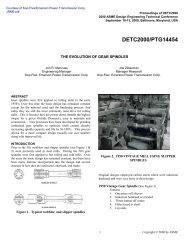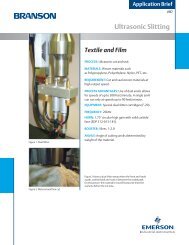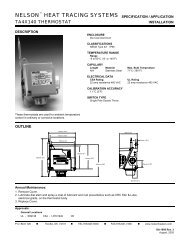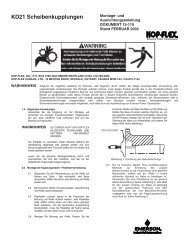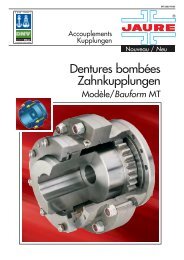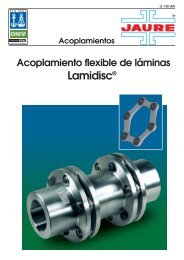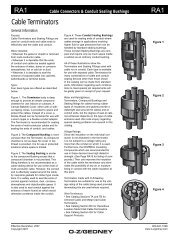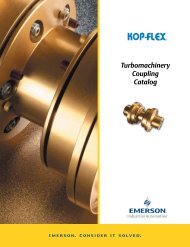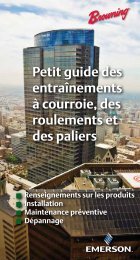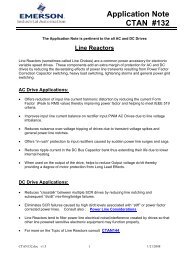Kop-Flex Industrial Coupling Product Catalog - Form 8887E
Kop-Flex Industrial Coupling Product Catalog - Form 8887E
Kop-Flex Industrial Coupling Product Catalog - Form 8887E
Create successful ePaper yourself
Turn your PDF publications into a flip-book with our unique Google optimized e-Paper software.
MAX-C ® Resilient <strong>Coupling</strong>s<br />
Selection Procedure - Type CB & WB<br />
MAX-C ® COUPLING<br />
TYPE CB AND WB<br />
SIZING AND SELECTION<br />
The use of type CB or WB will usually be determined by one or more<br />
of the following criteria:<br />
1. If a torsional analysis of the system is made, the analysis will<br />
indicate whether to use type WB or CB, the rubber block hardness<br />
and compound, and where the coupling should be located in the<br />
drive.<br />
2. If a system torsional analysis is not going to be made, follow the<br />
guidelines given below:<br />
a. Diesel Engine Drives:<br />
Consult Engineering.<br />
b. Electric Motor Drives:<br />
If there is a direct drive (no gearing) and the electric motor is<br />
the source of torsional shock or vibration, use a WB coupling<br />
mounted on the motor shaft and driven shaft. If a CB coupling<br />
is more readily available, it can be used.<br />
c. Speed Reducer:<br />
If there is a speed reducer involved and the source of torsional<br />
shock or vibration is from the driven machine, then usually a<br />
WB coupling should be mounted in the low speed shafting. If<br />
the drive arrangement precludes this, use a CB coupling in the<br />
high speed (motor) shafting.<br />
d. Speed Increaser:<br />
If there is a speed increaser involved and the source of torsional<br />
shock or vibration is from the high speed machine, use a WB<br />
coupling in the high speed shafting or, if this is not possible,<br />
use a CB in the low speed (motor) shafting.<br />
3. The choice of rubber block hardness and compound is determined<br />
from experience. General guidelines are:<br />
Steel Mill Drives - natural or nitrile rubber, 60 durometer.<br />
Grinding Mills, Ball Mills - Nitrile or high damping rubber, 60 or 70<br />
durometer.<br />
Synchronous Motors & AC Variable Frequency Motors - high<br />
damping rubber, 60 or 70 durometer.<br />
Diesel Engine Drives - natural rubber, 50 or 60 durometer.<br />
Determine <strong>Coupling</strong> Size<br />
There are two basic methods for selection of proper coupling size:<br />
Method 1<br />
When application PEAK, CONTINUOUS, AND VIBRATORY TORQUE<br />
LEVELS ARE KNOWN based on a system torsional analysis, select<br />
the smallest MAX-C type CB or WB, that has peak, continuous, and<br />
vibratory torque capacities exceeding those of the application.<br />
Method 2<br />
When application torques are NOT KNOWN, service factors must be<br />
used to make a selection. (If application peak, continuous and vibratory<br />
torques are established later, the selection based on method 2 should<br />
be confirmed by method 1).<br />
a) Determine PRIME MOVER FACTOR from Table on Page 59.<br />
b) Determine DRIVEN MACHINE FACTOR from Table on Page 59.<br />
c) Add these two factors together to obtain the TOTAL SYSTEM<br />
FACTOR.<br />
NOTE: For CB couplings, the total system service factor must be<br />
at least 3.0.<br />
d) Calculate the requirement of the application load in HP per 100<br />
RPM as follows:<br />
HP/100 RPM = Normal continuous HP x 100 x<br />
Total System Factor (TSF)__<br />
RPM<br />
e) Refer to peak ratings for the type of MAX-C® coupling selected<br />
from Tables 1 or 2 and select a coupling sized equal to or larger<br />
than the calculated requirements.<br />
Selection Example: A centrifugal compressor is driven by a 2,270<br />
HP synchronous motor at 1800 RPM.<br />
Prime Mover Factor = 1<br />
Driven Machine Factor = 2<br />
For a Total System Factor (TSF) of 3.0<br />
2,270 (HP) x 100 x 3.0 (TSF)__<br />
1,800<br />
Therefore: HP/100 RPM = 378.33<br />
The application requires a coupling with a rating of at least 378.33<br />
HP/100 RPM. Since a type WB is suggested for a Synchronous<br />
motor drive, a size 5 1/2 WB rated at 530 HP/RPM is the correct<br />
choice.<br />
56<br />
Bore Capacity<br />
Note the bore or shaft requirements of the application and compare<br />
to the maximum bore columns on pages 57 or 58 to confirm coupling<br />
size selection. Increase the coupling size if its bores are too small<br />
for the application.<br />
Operating Speed & Balancing<br />
Requirements<br />
The maximum operating speeds for the selected coupling must not<br />
exceed speeds shown in the tables. Type CB couplings Sizes 1 1/2<br />
through 4 will require component balancing when operating speeds<br />
exceed:<br />
Consideration must be given to dynamically balancing all Type WB<br />
couplings and Size 5 or larger MAX-C ® Type CB couplings when<br />
operating speeds exceed 2/3 of the catalog maximum speed, shown<br />
in Tables 1 & 2 on pages 57-58.<br />
Limited End Float<br />
Type WB and CB couplings can be furnished to limited end float<br />
(L.E.F.) requirements. Limited end float is usually required when<br />
the electric motor is of the sleeve bearing type and is furnished as<br />
standard by <strong>Kop</strong>-<strong>Flex</strong> for electric motors rated at 500 HP and higher.<br />
Spacer Type & Floating<br />
Shaft <strong>Coupling</strong>s<br />
For accurate and concentric location of the flex hubs and floating<br />
member at certain operating speeds, centering bushings may be<br />
required. Please contact <strong>Kop</strong>-<strong>Flex</strong> for details. Maximum allowable<br />
misalignment for Floating shaft and Spacer couplings, at speeds up<br />
to 500 RPM, is 1/2° at each end.<br />
For speeds above 500 RPM calculate the limits of misalignment as<br />
follows:<br />
Misalignment limit =<br />
If more information or assistance is needed to select a MAX-C ®<br />
coupling please contact <strong>Kop</strong>-<strong>Flex</strong>.<br />
Rubber Block Life<br />
The rubber drive block operating life should be at least five years...<br />
provided the coupling is selected, installed and operated (in terms<br />
of steady torque, peak torque, vibratory torque and misalignment) in<br />
accordance with criteria stated by <strong>Kop</strong>-<strong>Flex</strong>.<br />
<strong>Coupling</strong> Damping<br />
<strong>Coupling</strong> damping is provided by the Type CB & WB couplings<br />
through the high energy absorption characteristics of the elastomer<br />
drive blocks. The Type SBR compound is suggested when large<br />
amounts of damping are required.<br />
The amount of damping provided by the coupling can be calculated<br />
by the following formula:<br />
C = K<br />
Mw<br />
1/2° x<br />
500<br />
Operating RPM<br />
where C = <strong>Coupling</strong> Specific Damping....... lb. in. sec./rad.<br />
where K = <strong>Coupling</strong> torsional stiffness...............lb. in./rad.<br />
where w = Torsional vibration frequency............. rad./sec.<br />
where M = <strong>Coupling</strong> dynamic magnifier.non-dimensional<br />
<strong>Coupling</strong> dynamic magnifiers relative to rubber compound and<br />
durometer are as follows:<br />
Natural<br />
Rubber<br />
(Typical application<br />
Diesel<br />
Drives)<br />
Shore<br />
Hardness<br />
-<br />
Dynamic<br />
Magnifier<br />
Nitrile<br />
(Typical application<br />
Grinding<br />
Mill Drives)<br />
Shore<br />
Hardness<br />
-<br />
Dynamic<br />
Magnifier<br />
SBR High Damping<br />
(Typical application -<br />
Synchronous Motor<br />
Drives)<br />
Shore<br />
Hardness<br />
Dynamic<br />
Magnifier<br />
50<br />
12<br />
50<br />
10<br />
50<br />
4<br />
60<br />
9 60<br />
7 60<br />
3. 5<br />
70<br />
7 70<br />
5.<br />
5 70<br />
3<br />
80<br />
5 80<br />
4.<br />
5 80<br />
3





